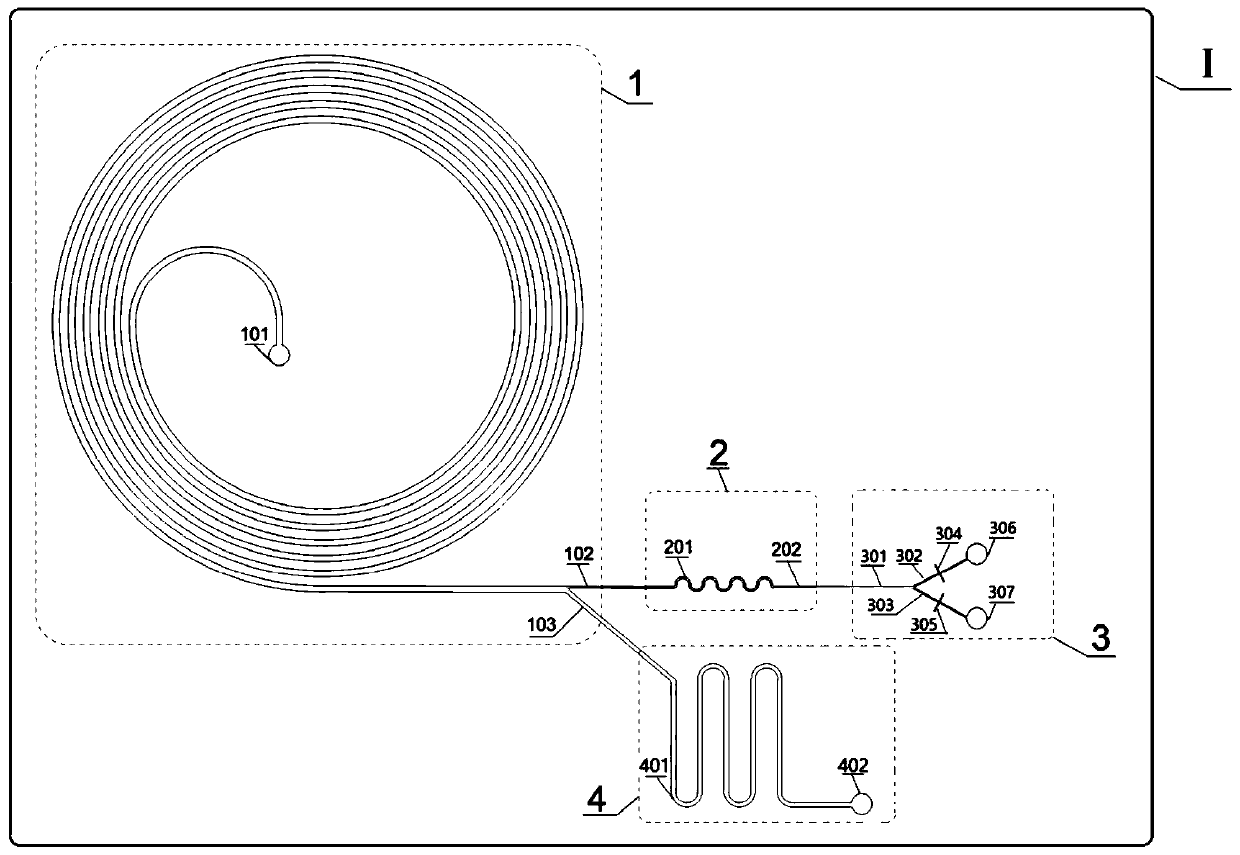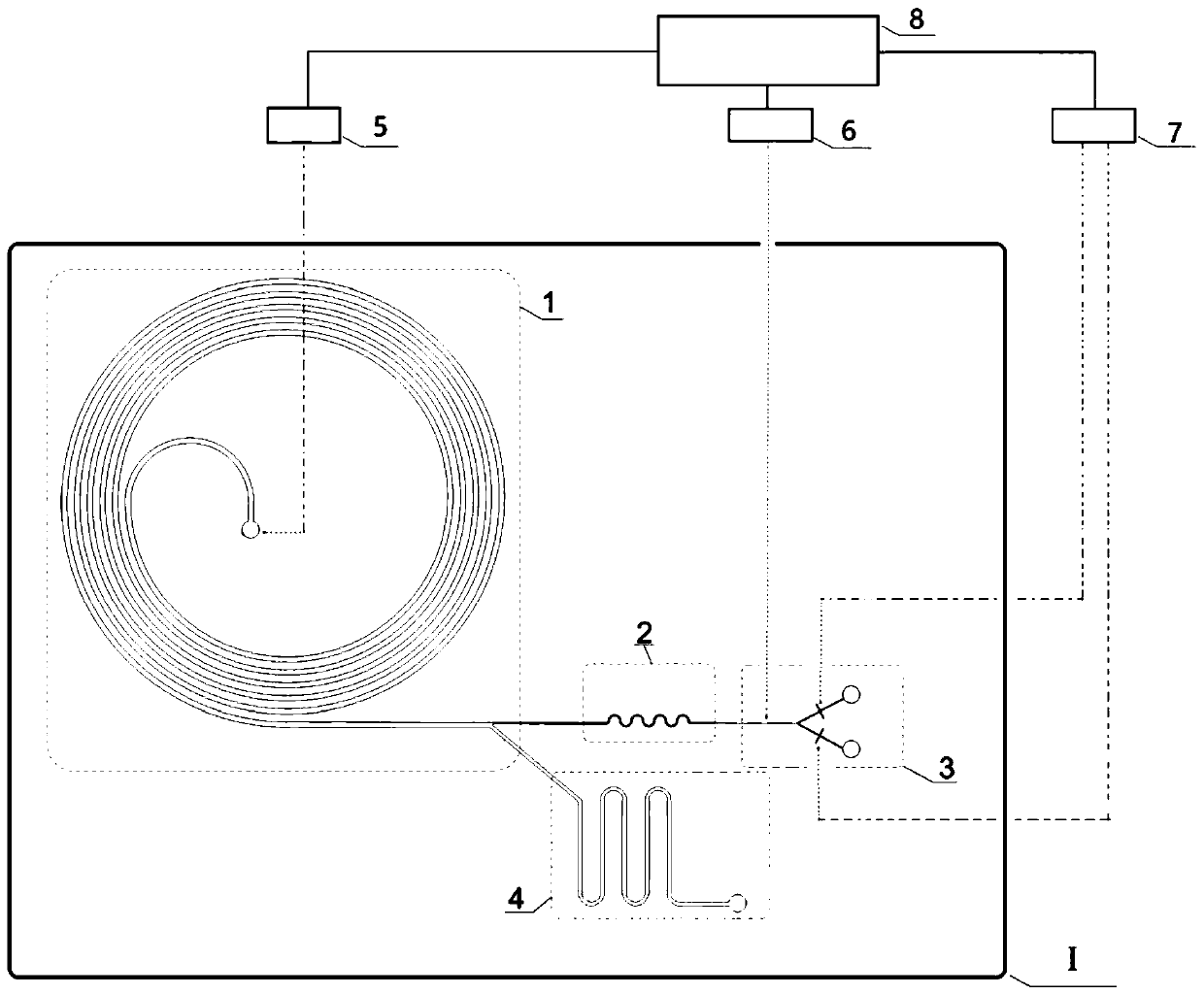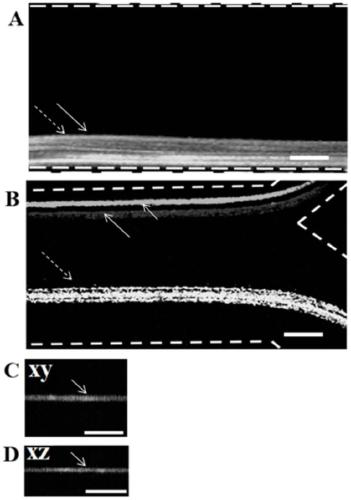Microfluid control system for separating, focusing and sorting of rare cells and application
A microfluidic system and rare cell technology, which is applied in the detection field of rare cells, can solve the problems of difficult CTCs release, incomplete separation, and low purity, to achieve online detection and rapid sorting, improve sensitivity and stability, The effect of improving sensitivity
- Summary
- Abstract
- Description
- Claims
- Application Information
AI Technical Summary
Problems solved by technology
Method used
Image
Examples
Embodiment 1
[0033] refer to figure 1 and 2 , a microfluidic system for separation, focusing and sorting of rare cells, its core component is a microfluidic system including "separation unit 1, focusing unit 2, sorting unit 3 and flow resistance matching unit 4" Chip device I; wherein:
[0034] The separation unit 1 is a clockwise or counterclockwise "spiral" channel structure, one end of the "spiral" channel structure is provided with a sample inlet 101, and the other end of the "spiral" channel structure is provided with inner, Two outer outlets, the inner outlet 102 is connected to the inlet of the focusing unit 2, and the outer outlet 103 is connected to the inlet of the flow resistance matching unit 4, which constitutes the separation of rare cells and other cells in the body fluid, and passes through the inner, The outer two outlets lead rare cells and other cells into focusing unit 2 and flow resistance matching unit 4 respectively;
[0035] The focusing unit 2 is a direct coupli...
Embodiment 2
[0040] As a further technical solution, in a microfluidic system for rare cell separation, focusing and sorting described in Example 1: the microfluidic chip device I is "glass-PDMS-glass" or " PDMS-PDMS-glass" three-layer structure chip; the curved channel 201 is an asymmetrical sinusoidal channel structure; the straight channel 202, the optical detection channel 301, the rare cell sorting channel 302 and the waste liquid The flow channels 303 are straight channels with a high aspect ratio greater than or equal to 2:1.
Embodiment 3
[0042] In this example, the microfluidic system described in Example 1 was used as the test device, and three fluorescent microsphere mixtures (mixing ratio of 1×10) with diameters of 5 μm (yellow), 10 μm (red) and 15 μm (green) 9 / mL: 1×10 6 / mL: 1×10 3 / mL), to simulate blood samples and red blood cells, white blood cells and CTCs in blood samples, and to illustrate the workflow and basic principles of the microfluidic system designed in the present invention by testing three kinds of fluorescent microsphere mixtures.
[0043] First, the mixture of three kinds of fluorescent microspheres (or the body fluid sample marked with multicolor fluorescence) is injected into the separation unit of the microfluidic chip device from the sample inlet by the micro-syringe pump. In this unit (i.e., inertial separation based on helical channels), using the inertial lift F L and Dean Drag Force F D Dependence on microsphere size (F L / F D ∝a P 3 ), three kinds of fluorescent microsph...
PUM
 Login to View More
Login to View More Abstract
Description
Claims
Application Information
 Login to View More
Login to View More - R&D Engineer
- R&D Manager
- IP Professional
- Industry Leading Data Capabilities
- Powerful AI technology
- Patent DNA Extraction
Browse by: Latest US Patents, China's latest patents, Technical Efficacy Thesaurus, Application Domain, Technology Topic, Popular Technical Reports.
© 2024 PatSnap. All rights reserved.Legal|Privacy policy|Modern Slavery Act Transparency Statement|Sitemap|About US| Contact US: help@patsnap.com










